Your Sound Bullet
Congratulations!
You now own your personal Sound Bullet.
Conceived and designed to streamline your workflow, the Sound Bullet is your pocket-sized tool for confirming audio inputs, outputs and anything in between.
Using your Sound Bullet to prevent and locate faults quickly and effectively will help you and your sound team ensure a solid and reliable signal chain.
We thought we’d make this small enough to fit in your pocket, so it’s always available when you need it!
I really hope you enjoy using your Sound Bullet.

2 Year Warranty
Sonnect guarantees the function of the Sound Bullet for a period of two years from the date of purchase. If the product becomes defective or malfunctions within two years of purchase, Sonnect will either repair the product free of charge or replace it.
These guarantee provisions do not cover damage caused by accidents, transportation, incorrect use, carelessness, third-party modifications, operation with non-specified outputs or inputs, Phantom Power voltages and currents outside of P48 standards (IEC 61938:2018) or charging adaptors non-compliant with USB power supply standards. The warranty will become void by carrying out any repairs or services by third parties.
The full Terms and Conditions can be found in the Terms And Conditions section of our website.
To obtain the benefit of this warranty, simply contact us at hello@sonnect.com

IMPORTANT: always power down your Sound Bullet after use. Leaving the device on until the battery is fully depleted may cause irreversible damage, resulting in the device being unable to power on again.
Disposal and Recycle

According to the Directive 2012/19/EU (WEEE – Directive on Waste Electrical and Electronic Equipment), valid for all European countries, this product has to be recycled at the end of its service life. In the event that the disposal of electronic waste is not possible, the recycling can also be done by Sonnect. For this, the device has to be sent free to the door to:
Sonnect S.r.l
Via Arturo Ferranti 5, 06055
Marsciano PG, Italy
Declaration of Conformity

CE Compliance Statement
We, the manufacturer, do hereby declare that this device is compliant with the limits of the European Council directive on the approximation of the laws of the member states relating to electromagnetic compatibility according to Directive 2014/30/EU and European Low Voltage Directive 2014/35/EU.

This device complies with part 15 of the FCC Rules. Operation is subject to the following two conditions:
(1) this device may not cause harmful interference, and
(2) this device must accept any interference received, including interference that may cause undesired operation
This equipment has been tested and found to comply with the limits for Class B digital device, pursuant to part 15 of the FCC Rules. These limits are designed to provide reasonable protection against harmful interference in a residential installation. This equipment generates, uses and can radiate radio frequency energy and, if not installed and used in accordance with the instructions, may cause harmful interference to radio communications. However, there is no guarantee that interference will not occur in a particular installation. If this equipment does cause harmful interference to radio or television reception, which can be determined by turning the equipment off and on, the user is encouraged to try to correct the interference by one or more of the following measures:
• Reorient or relocate the receiving antenna.
• Increase the separation between the equipment and receiver.
• Connect the equipment into an outlet on a circuit different from that to which the receiver is connected.
Consult the dealer or an experienced radio/TV technician for help
Warning: Changes or modifications not expressly approved by the party responsible for compliance
Product Overview
Signal Generator
When switched on, the Sound Bullet generates pink noise, which is routed to the output XLR by default.
A 1 kHz sine wave can be selected by pressing the SEL button (1).
Press the TO button (2) to route the generator to the 1/4” jack and the internal speaker/headphones output.
The generator’s output can be adjusted to three levels:
-40, -20 and -10 dBu (3).
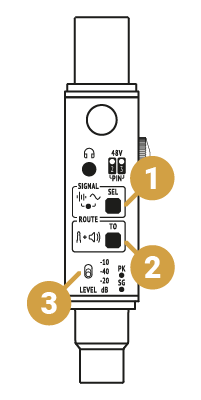
48V check
The Sound Bullet checks for Phantom Power voltage, which is individually metered on pins 2 and 3 of the output XLR. Two dedicated LEDs (4) will illuminate according to the P48 voltage standard (48 V ±4 V).
If the voltage detected is below 44 V and above 24 V, the LEDs will flash slowly.

Speaker/headphones output
The internal speaker (5) reproduces signals present on the input XLR or the 1/4” jack. The speaker and headphones output (6) share the same internal amplifier whose output level is adjusted by the side thumbwheel. If a 3.5mm jack (headphones) is plugged into the headphone port, the speaker mutes and its output is routed to the headphones.
Routing the internal generator to the 1/4” jack (by pressing TO) will also route it to the speaker and headphones.

XLR Input Metering
Two LEDs (7) will illuminate according to the RMS amplitude of the signal present on the input XLR. The SG LED is lit when the signal exceeds -20 dBu RMS, and the PK LED lights up when the signal exceeds +10 dBu.
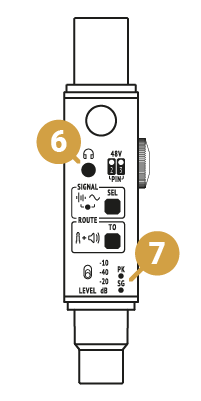
XLR Cable Tester
An XLR cable can be plugged into either end of the Sound Bullet to conduct a continuity test of the 3 XLR cores (8).
To enter (and exit) this function, hold the SEL button for 2 seconds. The Sound Bullet will automatically cycle through the pins. To select the pins manually, simply press SEL, and press TO if you wish to engage the automatic cycle again.
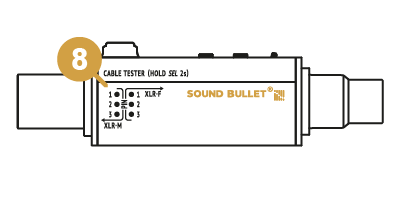
Conceptual Diagram
The following diagram sums up the Sound Bullet’s internal signal flow:
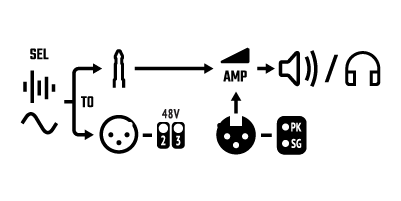
Examples of Use
Line-check a multicore
The Sound Bullet can test lines of a multicore line system connected to the inputs of a sound console. Activating Phantom Power on the input channels desired to be checked will allow for simultaneous test of all three cores of the XLR line. Simply switch on the Sound Bullet, which will start to generate pink noise, and plug it into the XLR line. The operator at the sound console will listen out for the pink noise while the sound engineer on the other end will check the 48V indication on the Sound Bullet (see table). This will determine if all pins of each XLR line are functional, and confirm that the patch is correct.
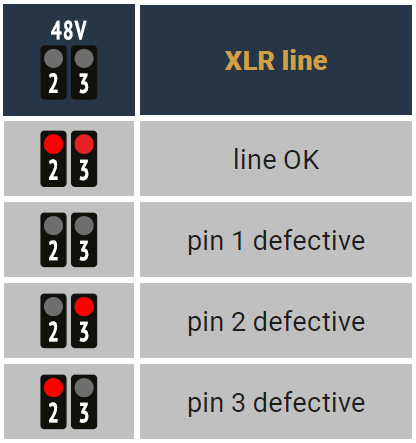
Test a DI box
Outputting an unbalanced signal via the 1/4” jack is very useful for quickly confirming one or multiple DI boxes connected to a mixing console.
The provided 1/4” jack-jack adaptor allows you to quickly plug the Sound Bullet straight into the hi-Z input of a DI Box.
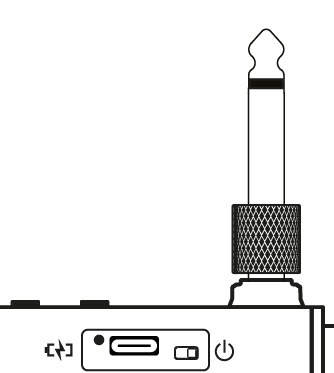
Simply switch on the Sound Bullet, which will start to generate pink noise. Direct the generator to the 1/4” jack by pressing TO. As a confirmation, you’ll
hear pink noise coming out of the speaker*, along with the function LED turning blue. With the jack adaptor inserted, plug the Sound Bullet into the DI box and check for pink noise being received at the mixing console.
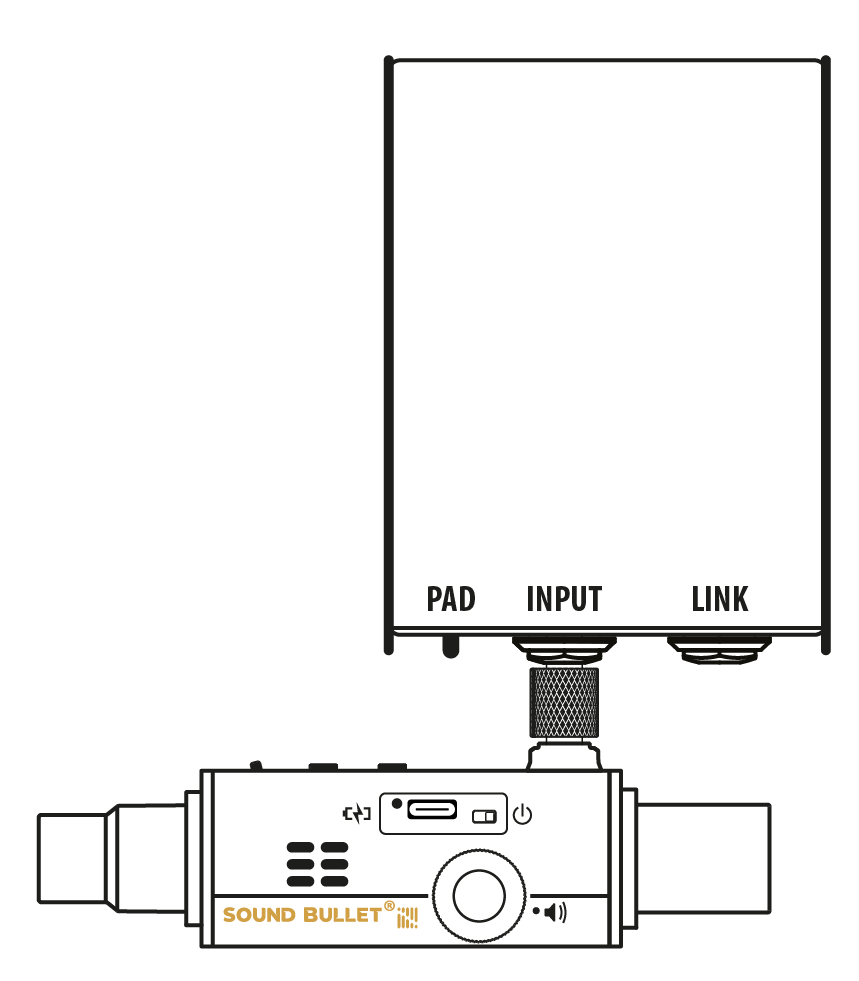
*Adjusting the speaker’s volume by the thumbwheel will not affect the output of the 1/4” jack.
Troubleshoot pedalboards
The Sound Bullet can be used as a quick diagnostic tool to troubleshoot FX pedalboards.
Press the TO button to switch between sending and receiving audio via the 1/4” jack. This will allow you to quickly inject a signal into the input (9) of FX pedals or listen to their outputs (10).
By tapping into each segment of the FX chain you can effectively detect which pedal contributes to the issue, testing out one effect unit at a time.
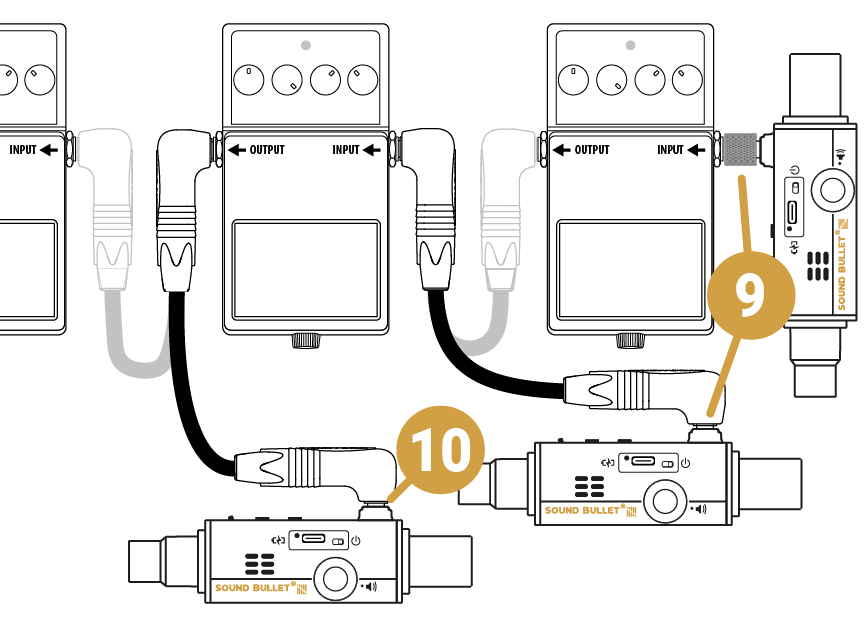
Check XLR feeds
Thanks to its internal speaker, your Sound Bullet can test balanced feeds layed out for wireless or hardwired IEMs, self-powered speakers or speaker amps/processors, recording and camera feeds.
When the Sound Bullet is switched on, signals present on the input XLR or 1/4” jack are reproduced by the internal speaker by default. Make sure the mixing console is sending either pink noise, music or any other type of audio into the line you are testing and simply plug that line into the Sound Bullet.
The input meter on the Sound Bullet will give you indication of signal presence ‘SG’ or of the signal being very loud, ‘PK’. This feature is very useful in noisy environments, or if you can’t get your ear close enough to the Sound Bullet’s speaker.
If you require a more accurate listening to the signal, plug your headphones into the Sound Bullet’s headphone port and adjust its output level with the volume thumbwheel on the side.
Charging
Charge your Sound Bullet using a standard USB-C cable. A full charge cycle takes about one hour and the device can be used while charging.
Battery
The LED by the USB-C port ![]() indicates the charging state while the Sound Bullet is being charged. The LED lights up red while the battery is charging, and turns off when it’s fully charged.
indicates the charging state while the Sound Bullet is being charged. The LED lights up red while the battery is charging, and turns off when it’s fully charged.
The function LED (11) next to the SEL button will blink white as a warning when the battery is:
• Low ![]() 3 white blinks
3 white blinks
• Out of charge ![]() 6 white blinks
6 white blinks
Consider recharging your Sound Bullet when the first ‘low battery’ warnings appear.
![]() Always power down your Sound Bullet after use. Depleting the battery may cause irreversible damage, resulting in the device being unable to power on again.
Always power down your Sound Bullet after use. Depleting the battery may cause irreversible damage, resulting in the device being unable to power on again.

Technical Specs
Typical Values and Tolerances

Warning: the Sound Bullet shouldn’t be used to test party-line intercom systems.
Note: if you own a Sound Bullet 1st Generation, don’t worry about it, nothing major changed. Feel free to get in touch if you have any questions 🙂 hello@sonnect.com